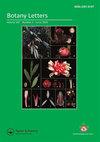The allopolyploid origin(s) and diversification of New Caledonian Grevillea (Proteaceae)
IF 1.3
4区 生物学
Q3 PLANT SCIENCES
引用次数: 1
Abstract
ABSTRACT The assembly of island plant communities is the result of a number of processes: immigration (dispersal), speciation, and extinction. Using four plastid genes and one low-copy nuclear gene, we investigated the origin of the New Caledonian Grevillea (Proteaceae), an otherwise largely Australian genus. In the combined plastid analysis, the species form two distinct clades, the exul (four species) and gillivrayi groups (six species), within group 3 of Grevillea. All New Caledonian Grevillea display two distinct copies of PHYA, one copy in group 3, and another in group 4. Previously published chromosome counts for G. meisneri and two new genome size estimates of G. gillivrayi and G. rubiginosa suggest that these plants are tetraploids. Altogether, the current data available suggest that New Caledonian Grevillea are allotetraploids, resulting from one or two hybridisation events between two or three distinct parents. A possible scenario is that modern Grevillea has descended from a hybrid swarm that formed 9–13 Mya between multiple immigrants (now extinct) that reached the island. Grevillea can be added to the list of island plant radiations with an early history of hybridisation and polyploidy. The relative importance, location and timing of these two mechanisms remain to be elucidated. The two groups of New Caledonian Grevillea may be easily distinguished by their inflorescences, flowers and fruits, with the gillivrayi group displaying greater ecological and morphological diversity. The seed characteristics of New Caledonian Grevillea are consistent with their pioneer behavior.新喀里多尼亚绿菜(变形科)的异源多倍体起源及其多样性
摘要岛屿植物群落的聚集是一系列过程的结果:迁移(扩散)、物种形成和灭绝。利用四个质体基因和一个低拷贝核基因,我们研究了新喀里多尼亚Grevillea(蛋白质科)的起源,该属在其他方面主要是澳大利亚的。在组合质体分析中,该物种形成了两个不同的分支,即外鞘组(四个物种)和鳃鞘组(六个物种),属于Grevillea的第3组。所有新喀里多尼亚Grevillea都显示出两个不同的PHYA拷贝,一个拷贝在第3组,另一个在第4组。先前发表的G.meisneri的染色体计数和G.gillivrayi和G.rubiginosa的两个新的基因组大小估计表明,这些植物是四倍体。总之,目前可用的数据表明,新喀里多尼亚灰蝶是异四倍体,由两个或三个不同亲本之间的一个或两个杂交事件产生。一种可能的情况是,现代灰蝶是由到达该岛的多个移民(现已灭绝)之间形成9-13 Mya的杂交群进化而来。Grevillea可以被添加到具有早期杂交和多倍体历史的岛屿植物辐射名单中。这两种机制的相对重要性、位置和时间还有待阐明。新喀里多尼亚Grevillea的两个类群可以很容易地通过它们的花序、花朵和果实来区分,其中gillivrayi类群表现出更大的生态和形态多样性。新喀里多尼亚灰蝶的种子特征与其开拓行为一致。
本文章由计算机程序翻译,如有差异,请以英文原文为准。
求助全文
约1分钟内获得全文
求助全文
来源期刊

Botany Letters
Agricultural and Biological Sciences-Plant Science
CiteScore
3.10
自引率
6.70%
发文量
54
期刊介绍:
Botany Letters is an international scientific journal, published by the French Botanical Society (Société botanique de France) in partnership with Taylor & Francis. Botany Letters replaces Acta Botanica Gallica, which was created in 1993, building on over a century of renowned publications by the Société botanique de France.
 求助内容:
求助内容: 应助结果提醒方式:
应助结果提醒方式:


